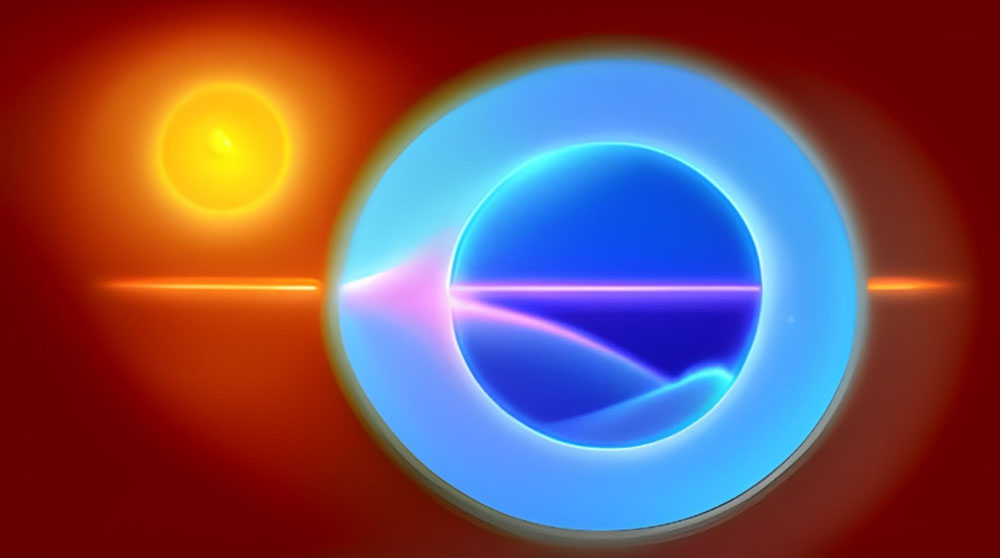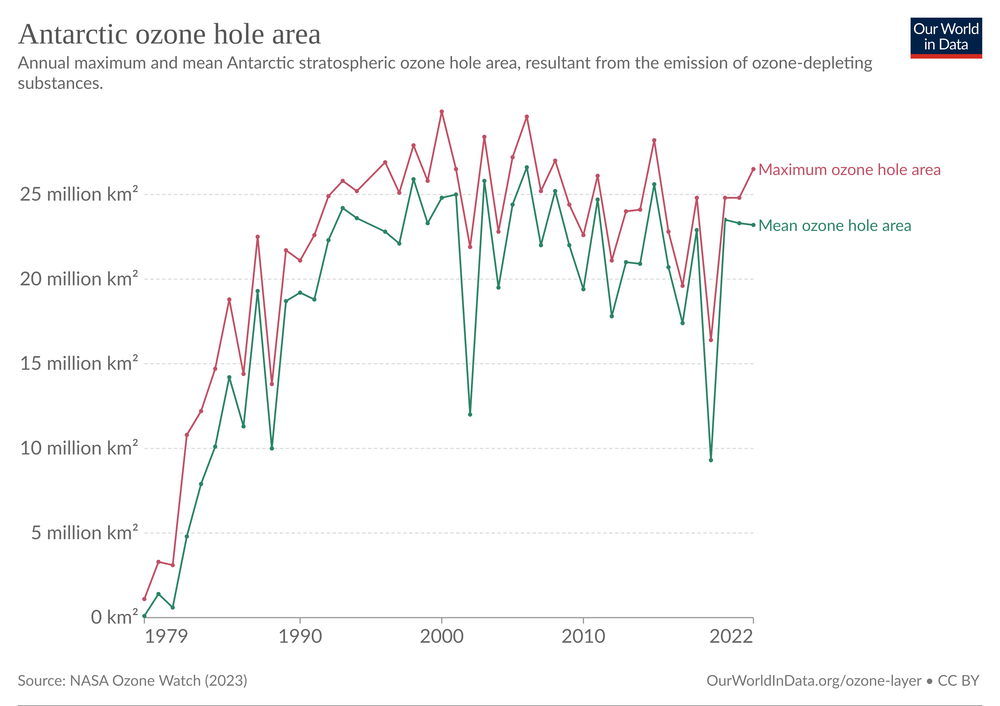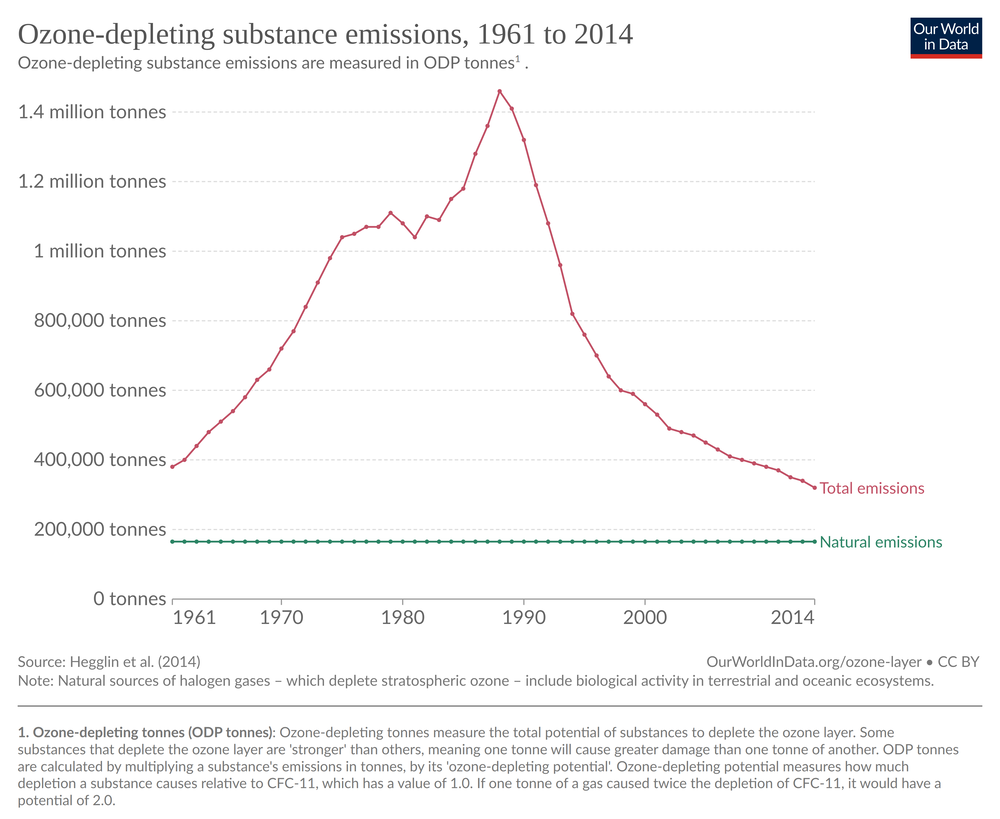
The year 2023 has started with good news for the planet: the ozone layer will fully recover within the next 40 years. This was the conclusion reached by UN experts who issued a report on compliance with the Montreal Protocol (which regulates emissions of substances that deplete the ozone layer). A few decades ago, the ozone hole seemed to be almost the most acute problem facing mankind.
So no problem existed?
No. The ozone depletion problem was indeed very serious and threatened to cause great trouble for humans. Thanks to a global ban on emissions of a number of chemicals, a catastrophic scenario was avoided: first, the ozone hole over Antarctica (the most famous and largest over the Earth) stopped growing, and then began to shrink. But it is too early to relax - mankind continues to poison the atmosphere with a bunch of harmful chemicals.
What is the ozone hole anyway?
Usually when people hear about the ozone hole, they imagine a literal hole in the atmosphere. In fact, an ozone hole is an area in the upper atmosphere where the concentration of ozone gas is below a certain threshold. If we apply the analogy to cloth, it is not a hole, but rather a scuff. In turn, atmospheric ozone is responsible for absorbing harmful ultraviolet (UV) radiation from the sun.
Doesn't ultraviolet light help produce vitamin D? And isn't it good for your health?
More intense exposure to ultraviolet radiation can actually reduce vitamin D deficiency in the body. The problem is that melanoma would be too much of a price to pay for an extra dose of vitamin D that could be obtained through less dangerous means, such as medicines.
By losing the ozone layer, the Earth would lose the "shield" that saves it from the Sun's UV radiation. People, animals, and plants would suffer as a result.
- UV radiation damages DNA in skin cells, resulting in an increased risk of skin cancers such as basal cell carcinoma and squamous cell carcinoma, as well as melanoma, which is more dangerous than cancer. The World Health Organization estimates that a 10 percent reduction in ozone concentration will result in an additional four and a half thousand melanoma cases and 300,000 cases of non-melanoma skin cancer per year.
- UV radiation damages the lens of the eye, which can lead to the development of cataracts. In 2005, it was estimated that in the United States alone, this threatened to result in 830,000 cataract patients by 2050.
- There are more exotic consequences: a 2011 study, for example, found a link between ozone depletion and severe sunburns in whales.
So what causes ozone holes to form after all?
The main cause is emissions of chlorofluorocarbons (CFCs), chemicals that rise into the stratosphere and destroy ozone molecules. For a long time they were used, for example, in refrigerators and aerosols. In 1974, the first scientific paper appeared linking CFC emissions to ozone destruction. For this discovery, its authors, American chemists Mario Molina and Sherwood Rowland, received the Nobel Prize in Chemistry in 1995 - together with the Dutchman Paul Krutzen.
So my aerosol deodorant should be thrown out?! And what about refrigerators - are they still destroying the ozone layer?
You no longer have to worry: modern aerosols and refrigerators do not harm the ozone layer. Instead of ozone-depleting chemicals, they now use safer analogues (chemically very similar, but without chlorine atoms).
After scientists established the connection between CFCs and the destruction of the ozone layer, it became clear that the process could be stopped simply by banning harmful substances. All that is needed is the political will and united efforts of the entire world community, because it is not enough to ban CFCs in one country or on one continent.
The first step toward banning CFCs was taken in March 1985, when two dozen countries, including the USSR, France, Germany, the UK and the US, signed the Vienna Convention for the Protection of the Ozone Layer.
The next step was the signing of the Montreal Protocol on Substances that Deplete the Ozone Layer in the fall of 1987. This international treaty, which came into force in 1989, contains a plan for the phase-out of CFCs and some other chemicals.
In 2009, the Vienna Convention and the Montreal Protocol were the first treaties in UN history to receive universal ratification, meaning that all the recognized states of the world formally acceded to them.
That's all well and good. But what about the ozone hole over Antarctica? Has it dissipated?
Not yet. The largest ozone hole is still located over the Antarctic, its area varies with each season, but can reach 25 million square kilometers. This is about twice the area of Siberia from the Urals to the Pacific Ocean.
The size of the Antarctic ozone hole is still very large, but there is a decreasing trend. If all countries continue to ban CFCs and other chemicals, the ozone hole over Antarctica will recover by about 2066, the authors of a new UN report predict.

If the hole is still there, can we talk about any success of the international effort?
Yes, we can.
In 2016, nearly three decades after the protocol was signed, scientists saw signs that the ozone layer was beginning to recover. By early 2022, stratospheric ozone concentrations in the mid-latitudes had dropped by 50 percent, returning to 1980 levels.
Back in 2009, NASA scientists modeled what the world would look like in 2040 without the Montreal Protocol and the ban on the use of CFCs: the ozone hole would have covered the whole world, and in temperate latitudes at noon on a clear summer day you could get a noticeable sunburn in 10 minutes. This apocalyptic scenario was avoided thanks to timely actions by the global community.
In 2003, former UN Secretary General Kofi Annan called the Montreal Protocol "perhaps the most successful international environmental agreement. Twenty years later, it remains perhaps the only example of how the combined efforts of politicians and scientists have led to rapid, positive change on a planetary scale.
How was it possible to negotiate for protection of the ozone layer?
Chemical manufacturers were certainly not happy when scientists accused their products of destroying the ozone layer. A DuPont executive, for example, wrote that "the ozone destruction theory is science fiction". But it soon became clear that potential substitutes for CFCs - propane, butane and isobutane - were cheaper to produce, so the industry's opposition waned.
In addition, environmental and consumer organizations conducted mass campaigns, including boycotts of companies using CFCs. This pressure forced some U.S. companies to abandon CFCs even before they were globally banned. So by the time the Montreal Protocol was adopted, the market for CFCs had already shrunk.
To make it easier for developing countries to reject CFCs, the U.S. and its allies provided $160 million in technology transfer. Finally, the protocol's success was aided by the fact that it imposed sanctions prohibiting trade in a number of ozone-depleting substances with those countries that did not sign it - encouraging other states to join the agreement.

Nevertheless, the road to a world without an ozone hole has been tortuous. In 2019, it was revealed that illegal emissions of trichlorofluoromethane (CFC-11), banned by the Montreal Protocol, had been growing for several years in two industrialized provinces in eastern China. CFC-11 was most likely used in the manufacture of Styrofoam. Chinese emissions threatened to significantly delay the recovery of the ozone layer.
Fortunately, four years later, the Chinese government has largely stopped trichlorofluoromethane emissions, allowing scientists to confirm that the ozone layer will fully recover within a few decades. China's emissions in recent years, while delaying a happy ending, only by a year, the report's authors noted.